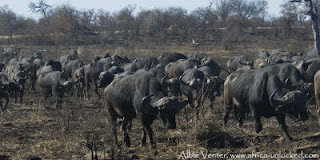 A while ago I stumbled upon and photographed this fascinating scene. The story was accepted as an article in Africa Geographic but subsequently I entered it into the Caught in th Act competition. A good call I suppose as it was then awarded first prize.
A while ago I stumbled upon and photographed this fascinating scene. The story was accepted as an article in Africa Geographic but subsequently I entered it into the Caught in th Act competition. A good call I suppose as it was then awarded first prize.My whole approach to photography is to use it as a tool to communicate the wonder of Nature. Thus I am presenting the sequence to those who care to read the somewhat lengthy blog post. Hope you enjoy and please feel free to let me know of your comments.
With its yellow belly clearly visible, I initially mistook the drama unfolding as a misplaced toy.
I soon enough realized that this was in fact a Stripe bellied Sand snake caught in the act of procuring its next meal, in this case a Turner’s Gecko Pachydactylus turneri.
The whole scenario played off not where one would expect to find these reptiles but on a recently stacked pile of bricks at a construction site This incident bears testimony to the fact that we do not necessarily have to travel the great African wilderness to observe nature’s dramas unfolding but it may happen in the unlikeliest of places – quite literally in our own back yards!
Initial interest and curiosity was rapidly replaced with a Paris-Dakar-like rush for my camera. Suffice to say the camera and me made it back in good enough state to capture the following images.
 When threatened, the gecko’s first line of defense is the well known shedding of its tail in order to fool predators, a distraction strategy known as autotomy. Sadly evident it proved ineffective and the only evidence left of its desperate attempt at escape is the blunt termination where its spiny tail used to be.
When threatened, the gecko’s first line of defense is the well known shedding of its tail in order to fool predators, a distraction strategy known as autotomy. Sadly evident it proved ineffective and the only evidence left of its desperate attempt at escape is the blunt termination where its spiny tail used to be.In addition to its venom it is interesting to note that in order to aid capture the snake coils around its prey constricting it. This killing method is more associated with primitive snakes which lack venom such as pythons and house snakes.
 Knowing that these interactions can last a mere few minutes I was struck by the time it took for the snake to kill its prey. A closer inspection from a different angle revealed the reason. The gecko, ever willing to bite managed to get hold of the snake’s neck preventing it from injecting its venom. It is difficult to imagine a more uncomfortable stale mate!
Knowing that these interactions can last a mere few minutes I was struck by the time it took for the snake to kill its prey. A closer inspection from a different angle revealed the reason. The gecko, ever willing to bite managed to get hold of the snake’s neck preventing it from injecting its venom. It is difficult to imagine a more uncomfortable stale mate! With its neck touching the base of its tail the gecko is holding on for dear life. The snakes determined constriction however finally pays off and the gecko’s grip starts to weaken. This allows the snake to deliver a proper bite to the gecko’s hind leg even though the gecko is still firmly locked onto the snake’s neck.
With its neck touching the base of its tail the gecko is holding on for dear life. The snakes determined constriction however finally pays off and the gecko’s grip starts to weaken. This allows the snake to deliver a proper bite to the gecko’s hind leg even though the gecko is still firmly locked onto the snake’s neck.At this stage the two have literally been at one another’s throats for more than an hour and a half. Satisfied that his opponent is sufficiently immobilized the snake starts searching for the head of the gecko from which it would start swallowing it.


Once the snake gets hold of the gecko’s head it lifts its prey’s entire body off the ground and disappears without any apparent harm into the nearest shrubs from where it would no doubt enjoy its hard earned meal.







